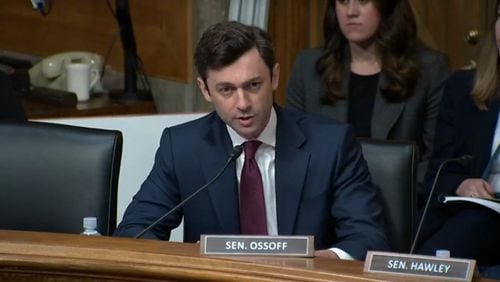Toxic metals leached from coal ash into the soil and groundwater at a South Georgia landfill, The Atlanta Journal-Constitution has learned, underscoring the dangers that the electricity-generating byproduct poses to the environment and surrounding communities.
The AJC this week pored over hundreds of pages of documents at the state Environmental Protection Division office in Atlanta detailing the discovery of beryllium and other toxic metals at the landfill, as well as cleanup efforts.
The news comes as the landfill’s operator, Republic Services, is pursuing plans that could allow it to accept millions of tons of coal ash annually, a possibility that has alarmed Wayne County residents and elected officials.
Republic reported the problem in December 2011. More than two years passed before it shuttered the coal ash facilities, the files show. EPD officials said that the metals, which could cause cancer and damage to the nervous system in sufficient quantities, may have also leached into the ground months, if not years, earlier.
It’s not clear how much of the toxic metals leached into the ground, nor how far they might have traveled. Republic, a national solid waste disposal company, began an extensive cleanup of the ash leakage last fall, and the EPD says there’s no evidence the metals have reached nearby wetlands.
Wayne County residents say they should have been informed about the leak.
“They assured us just in the last couple of weeks that there had never been any problem with coal ash whatsoever,” Wayne County Commission Chairman Kevin Copeland said. “It makes me mad, frankly, that they had something spill into our environment and we didn’t know about it.”
Republic accepted coal ash from a Jacksonville, Fla., utility between 2006 and 2014 and still has a permit to handle what the federal Environmental Protection Agency considers a nonhazardous material. Officials say they have no current plans to take in ash, but the company has applied for a wetlands permit from the U.S. Army Corps of Engineers to build a 250-acre rail yard alongside the Wayne County landfill.
Ash could be transferred from trains — up to 100 cars long with a concrete pad underneath capable of capturing spilt coal ash — to trucks and ferried to a 90-acre section of the landfill lined with polyethylene and clay to keep ash from leaching into the ground.
The ash, as much as 10,000 tons daily, could come from Georgia and other states. The Broadhurst Environmental Landfill, about 230 miles southeast of Atlanta, currently accepts less than one-fifth that amount of household waste, construction debris and other trash.
Community outrage over the rail yard plans caused the corps to extend the public comment period on Republic’s application from early February to early March. Copeland said the county will hold a public hearing within the next month.
The company says the rail yard expansion does not pose a danger to residents. “We’re confident this project is something we can manage safely and in an environmentally conscious way,” said Jeremey Poetzscher, the landfill’s environmental manager.
Coal ash disposal isn’t just a hot-button issue in rural Georgia. Coal-fired power plants, many surrounding metro Atlanta, dispose of their ash in nearby ponds and landfills. Georgia Power, for example, maintains 29 ash ponds and 10 landfills across the state and plans to shut down all of them over the next few years.
Republic first detected beryllium and zinc, “above regulatory standards,” in December 2011, according to a notification letter sent to the EPD the following spring. But it could’ve reached the groundwater sooner, the EPD said in response to an AJC question, “as it takes a period of time for the contamination to migrate to and through the subsurface to (the) monitoring wells.”
Republic mixed coal ash, wood chips and soil with nonhazardous liquids and sludges, as much as 70,000 gallons daily, between 2006 and 2014. The solidified material was then put in the landfill. The “solidification pits” stood about a football field away from wetlands. Little Penholloway Creek was two football fields away.
Environmental consultants hired by Republic to investigate the leached coal ash suggested that the beryllium might have come naturally from the soil. In a September 2013 response, though, the EPD wrote that the agency “does not concur that statistically significant increases” of beryllium came just from the soil.
Republic stopped taking coal ash sometime in 2014. It “decommissioned” the solidification facilities in March 2014, at least two years after beryllium was first detected. Poetzscher and EPD officials say state environmental rules allowed Republic to determine, first, whether natural causes or the landfill itself led to the damage. When it became clear that the leaching was caused by the solidification process, the operation was shut down.
The company began remediating the problem — destroying the solidification structures, scooping out three or more feet of soil surrounding the buildings and sinking a number of new monitoring wells — last fall. It will file semi-annual updates with the EPD.
A consultant’s 2015 report showed that beryllium and cadmium exceeded Georgia drinking water standards. Arsenic levels in the soil “slightly exceeded” the standards. Their latest report, though, labeled the metals “below detection levels.” The metals, the EPD believes, are no longer migrating toward the wetlands.
“They are making progress,” said Sarah Barr, an EPD geologist. “They’ve got a handle on meeting our groundwater plan. I’m generally satisfied, (but) they’ve just implemented a portion of the remediation plan. … We’ll just have to see if it’s going to correct the problem.”
About the Author






